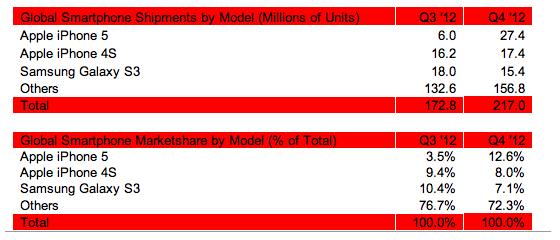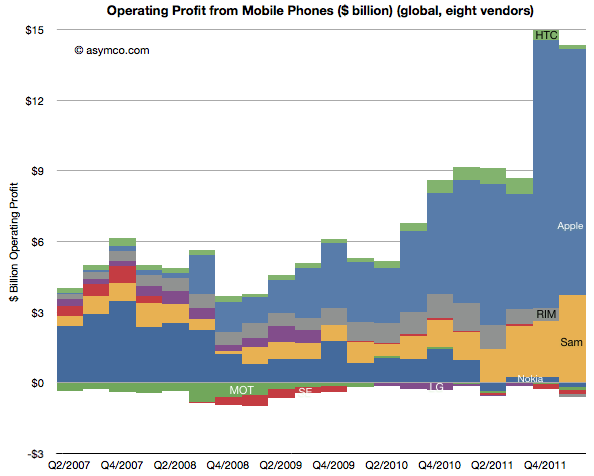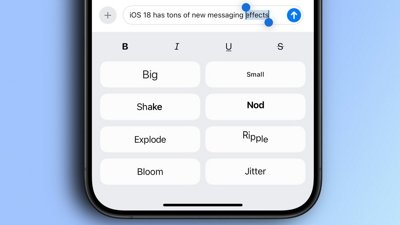Conventional wisdom says Apple both desperately needs a cheaper iPhone model to compete with low end Android and Nokia offerings, while also holding that lower margins would destroy the company's profitability. Its history offers examples of reaching a middle ground.
Is Apple's high end iPhone 5 failing?
Apple's stock tumbled 5.3 percent this week after speculation that $20 million worth of extra inventory at a key supplier must mean iPhone 5 sales are slipping. Of course, it could also mean that Apple shifted to either a new supplier or a new generation of components.
At the same time, top U.S. carriers AT&T and Verizon Wireless released quarterly figures that indicate that not only are iPhone sales higher than the previous year, but that iPhone 5 continues to account for half of all iPhone sales.
Since Apple doesn't detail the exact mix of iPhone models being sold globally or for each region sales group (for competitive reasons), carrier reports are helping to illuminate the fact that most of the new iPhones being sold are Apple's latest and greatest model.
That's in sharp contrast to Samsung in Q4, when just 15.4 million, less than a quarter of its total 60 million phones sold, were its higher end Galaxy S3. The 2011 iPhone 4S by itself beat the Galaxy S3 by two million units globally and iPhone 5 sold 27.4 million units.
Apple continues to struggle to make enough iPhones to meet global demand, so finding a market for high end iPhones is not as much of problem for the company as its competitors, who continue to ship phones and tablets that often don't end up actually getting sold to end users.
Apple may however need to more aggressively target the low end of the market.
But Apple never competes on price, right?
Asked when Apple would build netbooks in 2008, Steve Jobs famously said "we don't know how to make a $500 computer that's not a piece of junk, and our DNA will not let us ship that."
A report by Jun Yang, Anand Krishnamoorthy and Jungah Lee, published by Bloomberg in February insisted that Apple's new chief executive Tim Cook "already reversed a vow by late founder Steve Jobs that the company wouldn’t introduce a scaled-back and cut-price version of the iPad."
Of course, Apple has actually cut its prices before. WebObjects dropped from $50,000 to $699, and then became free. Mac OS X Server unlimited dropped from $1,000 to $499 to $49.99. Final Cut Pro dropped from $1000 to $299. Aperture fell from $499 to $79.99.
Well perhaps Apple just doesn't lower prices in hardware, then? No that's not right either; the company extended its dominance in digital music players a decade ago by introducing the iPod mini and then the iPod nano and shuffle. Three years into the iPad, Apple similarly released its smaller, lighter, cheaper and slightly less profitable iPad mini.
And don't forget the Mac mini and Mac mini server, or the much cheaper $99 Apple TV that replaced the original priced at $229. And we don't even need to discuss cheaper Macs, iPods and iPads because Apple has also sharply discounted the iPhone itself, starting with the original model that was repriced from $599 to $399 within months of its unveiling.
Then, one year later, Apple introduced the improved iPhone 3G model with a cheaper build, packing more power and features in a plastic case that allowed it to sell for half the price, just $199 on contract.
Since then, each new generation of iPhone kept getting better at the same price, and previous years' models are now sold at a $100-200 discount. This pricing pattern has allowed Apple to offer a "good, better, best" selection that ranges from $0 to $199 with a contract.
Competing on price without a subsidy
Apple's not being significantly undersold in markets like the U.S. where carrier subsidies effectively erase the low end of the market in order to sell more expensive, data plan connected devices.
However, in emerging markets, developing countries and prepaid markets, Apple is being undercut by bargain bin feature phones such as Nokia's S40 platform, low end Android offerings, Windows Phone models, Blackberry and other cheaper options.
Without a subsidy, Apple's cheapest iPhone 4 remains around $450, or about $485 in the UK and just over $520 in France (at the prevailing exchange rates). At those prices, its not hard to see why Android is penetrating the budget market in Europe far more successfully than in America.
So far, Apple has focused on releasing new models that either extend the state of the art or expand carrier options. Since the release of the original iPhone 4, Apple has significantly revised the design only a few times: first to make it compatible with Verizon (and later Sprint) via CDMA, then to release a global iPhone 4S model, then to offer the LTE-capable iPhone 5.
Apple hasn't made an intentionally cheaper new version of the iPhone since the 3G in 2008. That appears to have been the optimal strategy over the past four years, given that it has enabled Apple to earn 73 percent of the industry's profits as Samsung, Nokia and others have less effectively pursued market share via lower end phones.
Going forward however, it appears the iPhone is now reaching the turning point the iPod hit in its fourth generation: a position of dominance over the high end that makes it increasing sensible to turn the company's attention toward reaping the lower end of the market.
The 2004 iPod mini allowed Apple to rapidly eat up remaining market share among lower end MP3 players. Last fall's iPad mini appears to have similarly helped the company to hold onto and even expand its wide lead in tablets. A cheaper iPhone would very likely help the company's efforts in making traction in markets like India and China, where vast markets are demanding a cheaper device.
What about the less successful Mac mini?
In addition to the iPod mini and iPad mini, there's also another recent example of Apple addressing the lower end of the market with less success: the Mac mini.
Originally released in 2005, Apple appeared hopeful that PC users would buy the $599 model to replace their existing box, potentially reusing their same keyboard. mouse and display. The new model wasn't nearly as successful as is mini siblings in the iPod and iPad families. Most desktop Mac buyers continue to buy iMacs.Would a cheap new iPhone work out as well as lower end iPods and iPads have, or might it sell as unexceptionally as the Mac mini?
So the question remains: would a cheap new iPhone work out as well as lower end iPods and iPads have, or might it sell as unexceptionally as the Mac mini?
This all happened before
In addition, there's also a warning example further back in Apple's past. Way back in 1991, the company decided it needed cheaper Macs to compete with the expanding array of lower end DOS PCs.
Existing Macs had been selling from $3,800 to $10,000, equal to higher end IBM PCs. But no-name clone PC were being offered for closer to $1,000.
Apple's plan to offer lower cost Macs back then was to simply repackage old models. It recycled the 1986 Mac Plus as the Mac Classic for $999, and sold its 1987 Mac II in a new box it called the Mac LC, for $2,500. This helped Apple expand its offerings and sell more machines, but overall consumers weren't really that impressed with Apple's approach to the low end of the PC market.
In modern day terms, the "cheap Macs" plan of 1991 would amount to Apple today offering its original 2007 iPhone for $99, and its iPhone 3G for $199. Those models would technically be very price competitive, but they would be terrible phones to sell today, given users' current expectations.
They couldn't run today's iOS software or apps (much the same way the 1991 cheap Macs couldn't run a variety of titles popular at their release), and such repackaged old iPhones wouldn't compare well in perceived performance to the intentionally low end models Nokia is currently selling.
Cheap new iPhones might instead just enhance the notion that Apple's products are overpriced (as the 1991 Classic and LC did) while helping the company to earn less money while dealing with more product models and the operational headaches that come with that.
Apple needs to be cautious in developing a cheaper iPhone today not to make the same mistakes.
Another example of targeting a low priced iPhone
There's yet another example of Apple targeting a specific segment of customers who need a lower price: educational iMacs.
Apple actually developed a special eMac model in 2002 just for education. Today, the company continues to sell a lower end iMac model specifically for the education market, with lower specs that drive the price down but also make it in general a poor value for most general purpose users.
Following that model, rather than just recycling old existing iPhones at lower prices, Apple would need to develop an intentionally cheaper version of the iPhone, which it could potentially market exclusively in developing countries or attach to low end prepaid carriers such as WalMart, MetroPCS and Virgin Mobile, reducing the risk of eating into higher profit models.
Apple doesn't like to design lots of new model variety, as every new model creates new complexity in operations: forecasting, component procurement, inventory management and so on. Were Apple to create a specially value engineered iPhone, it might likely take the place of the iPhone 4
The design of the iPod touch demonstrates how Apple can build a lower end device with some component compromises to reach a lower price target. While a 32GB iPhone 5 has an unlocked price of $749, the similar generation 32GB iPod touch costs just $299.
The price gets that much lower not just by dropping its mobile hardware, but also through the use of a cheaper A5 with less system RAM and lower end camera. But the new iPod touch doesn't come across as a low end, cheap device.
The advancement of new generations of hardware components is occurring at such a rapid pace that it now may make more sense for Apple to design both a new high end "iPhone 5S" and a new low end iPhone, rather than just continuing to sell the iPhone 4S and 5 at a discount at existing price tiers.
The broad price range of iPods, including the fact that Apple now sells two generations of iPod touch, gives the appearance that a cheaper new specially designed iPhone is overdue. If it makes sense to custom value-engineer the low end of the iPhone range, this is the time to do it.
At the same time, Apple may also achieve a similar result by discounting or even financing its existing models for users, making iPhones more readily affordable to price sensitive users without complicating its supply chain operations with an entirely new model.
 Daniel Eran Dilger
Daniel Eran Dilger






-m.jpg)






 Malcolm Owen
Malcolm Owen
 Oliver Haslam
Oliver Haslam
 Amber Neely
Amber Neely
 Marko Zivkovic and Mike Wuerthele
Marko Zivkovic and Mike Wuerthele

 Andrew Orr
Andrew Orr


-m.jpg)








138 Comments
Another reason to introduce a new, less expensive iPhone mini is to unite everything this year with the lightning connector. Apple replaces the iPad 2 at $399 with the current iPad (4) when introducing the new iPad, and no more 30 pin connectors.
Bingo. Great article. If the iPhone 4 only costs $200 or so to make (guessing here), then if they sell it for $300, they are making their typical profits.
Prices for technological products always come down, of course. Even for Apple. Its their game to lose or win. And winning doesn't mean more than 50 percent share. And losing could be a 10 percent share. 30 would be healthy - worldwide.
The rest of the world loves the iPhone, too, but it's more than a months income for a lot of people. So they buy Samsung or Blackberry at 1/4th the price. Yeah, not the greatest phones, crappy in fact, having used them, but people do what they can do.
Apple doesn't need to be the premium brand. They can have a cheaper model of stuff.
" Tim Cook "already reversed a vow by late founder Steve Jobs that the company wouldn%u2019t introduce a scaled-back and cut-price version of the iPad." That's the stupidest comment I ever heard. By this guys logic Apple, then has done it with virtually every product they make. 13" Macbook Pro 11" Macbook Air 21" low end iMac All "scaled-back" "cut-price" versions of their full versions. (again; if you are going by this logic)
[quote name="isaidso" url="/t/157087/opinion-can-apple-afford-to-go-cheaper-with-new-iphones#post_2314059"]" Tim Cook "already reversed a vow by late founder Steve Jobs that the company wouldn%u2019t introduce a scaled-back and cut-price version of the iPad." That's the stupidest comment I ever heard. By this guys logic Apple, then has done it with virtually every product they make. 13" Macbook Pro 11" Macbook Air 21" low end iMac All "scaled-back" "cut-price" versions of their full versions. (again; if you are going by this morons logic)[/quote] Damn, we all know DeD is a fanboy and writes the best fanboy pieces of all tech sites but you don't have to go name calling... Asshole.
"Tim Cook "already reversed a vow by late founder Steve Jobs that the company wouldn't introduce a scaled-back and cut-price version of the iPad."
I'm with you. Steve Jobs never made such a vow. All he said was that their competitors were going down the wrong road with their 7" tablets running scaled up mobile phone software. iPad Mini doesn't do that.